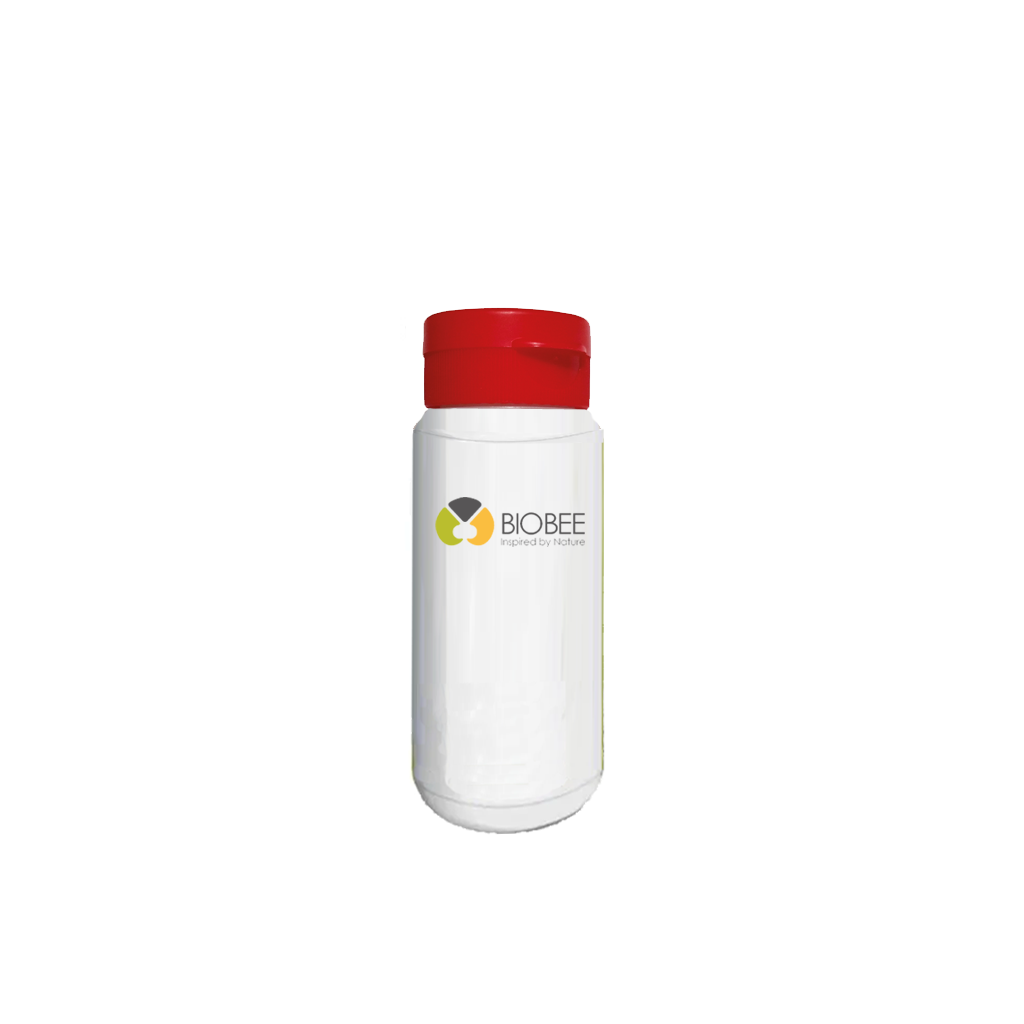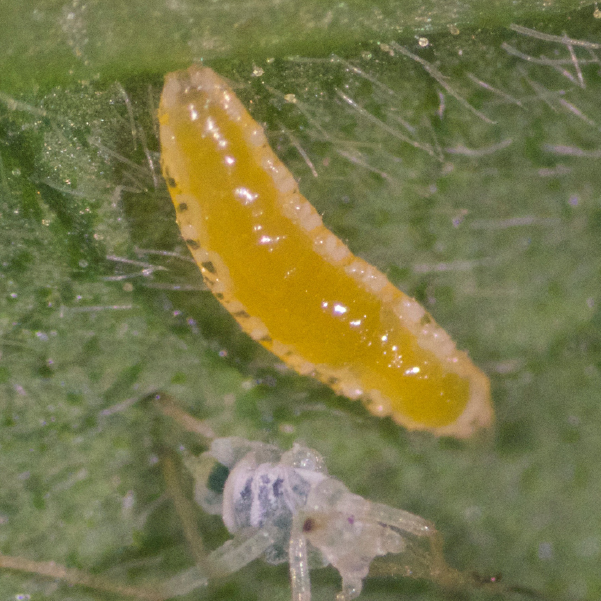BioBee BioAphidoletes - Aphidoletes aphidimyza pupae (1,000 pupae / bottle)
130-110-03-130023010
Availability:
backordered
Shipping time if backordered::
jusqu'à 2 semaines
In case of backorder::
Only replenished IF YOU ORDER IT
MAIN TARGETS
Aphids (many species).
ADDITIONAL TARGETS
-
TIPS
Release early to give time for larval stages to develop since only this stage feeds on aphids. Can diapause with cooler weather and short days (>12 hr.).
D-boxes can be used to apply BioAphidolete throughout the crop.
PRODUCT DESCRIPTION & PACKAGING
BioAphidoletes (Aphidoletes aphidimyza), commonly referred to as the gal midge, is a midge whose larvae feed on over 70 aphid species. Adults are small, delicate, mosquito-like flies with long, dangling legs and long antennae. Their eggs are oval, minute ( 0.1 mm – 0.3 mm) and orange. Adult A. aphidimyza feed on honeydew, their larvae (which look like orange maggots) although tiny, feed and consume larger aphids. Depending on their food source, they are bright-orange to red.
Aphid colonies secrete a honeydew odor that attracts adult A. aphidimiza. They deposit their eggs in these colonies so the larvae have a direct food source once they hatch. The larva paralyzes the aphids and proceeds to feed on them.
This predatory midge feeds on more than 70 different species of aphids. Shipped as pupae, the mosquito-like adults can be released into greenhouses, nurseries, interiorscapes, orchards and gardens. They rapidly disperse looking for aphid colonies to lay their eggs. The orange-colored maggot-like larvae feast on surrounding aphids while adults are sustained by pollen and nectar. Under suitable conditions, these delicate insects provide sustained seasonal protection from aphid outbreaks.
BioAphidolete is packaged in a container with 1,000 parasitized pupae.
STORAGE
- Storage temperature: 4-8°C (39-46°F)
- Do not store in sunlight
- Treat area against ants
- Roll back & forth before use
- Store horizontally
APPLICATION
- Before application, treat the area against ants.
- BioAphidoletes is shipped in insulated, chilled boxes. Packaging must be kept intact until placed in the field.
- Keep in a cool location until release.
- Place the product adjacent to aphids hot spots.
- Distribute the wasp pupae in the D-box and place them on the branches of the plant.
- Do not expose the bottles to direct sunlight.
The amount and frequency of the application (introduction rate) is determined by the target crop, level of infestation, weather conditions and damage inflicted to the crop.
DISCLAMER
Before combining this product with any chemical pesticide in the crop, please consult your BioBee technical field representative.
BioBee Sde Eliyahu Ltd. produces and markets biological products. Production is carried out using innovative techniques under controlled quality assurance standards such as ISO 9001:2015, as well as IOBC’s international standards for mass-production of insects. All products are tested to meet specification requirements before leaving the factory.
The success of biological pest control is affected by the crop’s initial pest population (upon application of the product), weather conditions and chemical residue present in the crop, among other possible aggravating factors.
Under no circumstance shall BioBee or Groupe Horticole Ledoux inc. be liable for the outcome of the implementation in the field, as it has no control over local conditions, the application method, or the possible improper treatment/storage of the product.
Specifications
| Instruction / | delivery |
MAIN TARGETS
Aphids (many species).
ADDITIONAL TARGETS
-
TIPS
Release early to give time for larval stages to develop since only this stage feeds on aphids. Can diapause with cooler weather and short days (>12 hr.).
D-boxes can be used to apply BioAphidolete throughout the crop.
PRODUCT DESCRIPTION & PACKAGING
BioAphidoletes (Aphidoletes aphidimyza), commonly referred to as the gal midge, is a midge whose larvae feed on over 70 aphid species. Adults are small, delicate, mosquito-like flies with long, dangling legs and long antennae. Their eggs are oval, minute ( 0.1 mm – 0.3 mm) and orange. Adult A. aphidimyza feed on honeydew, their larvae (which look like orange maggots) although tiny, feed and consume larger aphids. Depending on their food source, they are bright-orange to red.
Aphid colonies secrete a honeydew odor that attracts adult A. aphidimiza. They deposit their eggs in these colonies so the larvae have a direct food source once they hatch. The larva paralyzes the aphids and proceeds to feed on them.
This predatory midge feeds on more than 70 different species of aphids. Shipped as pupae, the mosquito-like adults can be released into greenhouses, nurseries, interiorscapes, orchards and gardens. They rapidly disperse looking for aphid colonies to lay their eggs. The orange-colored maggot-like larvae feast on surrounding aphids while adults are sustained by pollen and nectar. Under suitable conditions, these delicate insects provide sustained seasonal protection from aphid outbreaks.
BioAphidolete is packaged in a container with 1,000 parasitized pupae.
STORAGE
- Storage temperature: 4-8°C (39-46°F)
- Do not store in sunlight
- Treat area against ants
- Roll back & forth before use
- Store horizontally
APPLICATION
- Before application, treat the area against ants.
- BioAphidoletes is shipped in insulated, chilled boxes. Packaging must be kept intact until placed in the field.
- Keep in a cool location until release.
- Place the product adjacent to aphids hot spots.
- Distribute the wasp pupae in the D-box and place them on the branches of the plant.
- Do not expose the bottles to direct sunlight.
The amount and frequency of the application (introduction rate) is determined by the target crop, level of infestation, weather conditions and damage inflicted to the crop.
DISCLAMER
Before combining this product with any chemical pesticide in the crop, please consult your BioBee technical field representative.
BioBee Sde Eliyahu Ltd. produces and markets biological products. Production is carried out using innovative techniques under controlled quality assurance standards such as ISO 9001:2015, as well as IOBC’s international standards for mass-production of insects. All products are tested to meet specification requirements before leaving the factory.
The success of biological pest control is affected by the crop’s initial pest population (upon application of the product), weather conditions and chemical residue present in the crop, among other possible aggravating factors.
Under no circumstance shall BioBee or Groupe Horticole Ledoux inc. be liable for the outcome of the implementation in the field, as it has no control over local conditions, the application method, or the possible improper treatment/storage of the product.
| Order-driven inventory |























